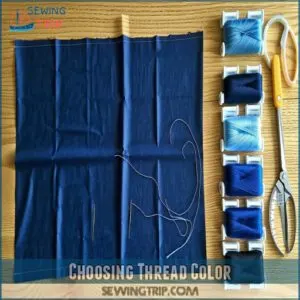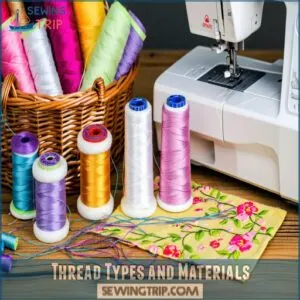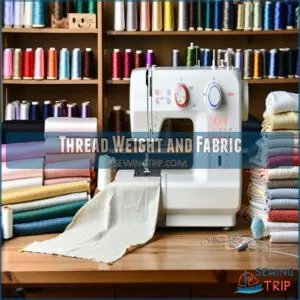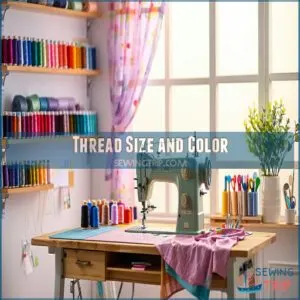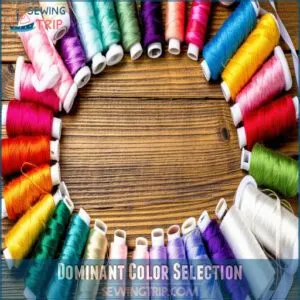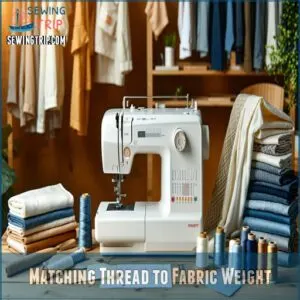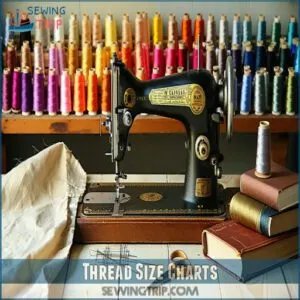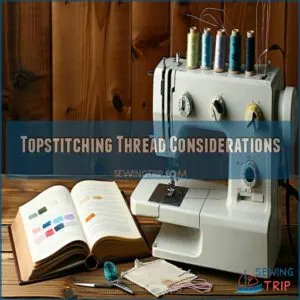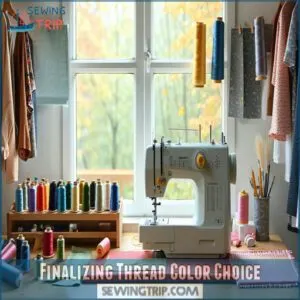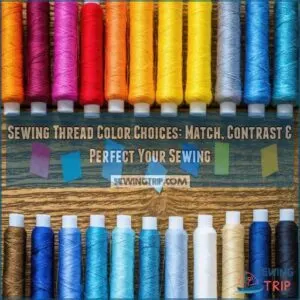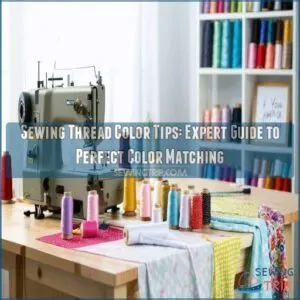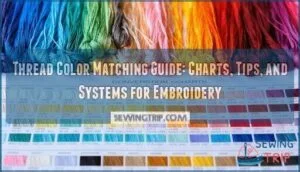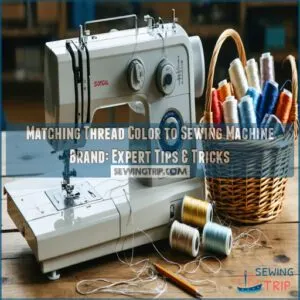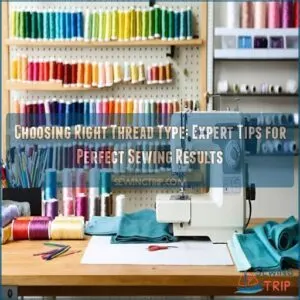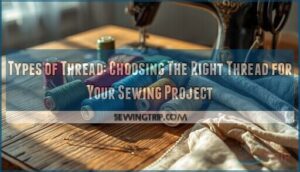This site is supported by our readers. We may earn a commission, at no cost to you, if you purchase through links.
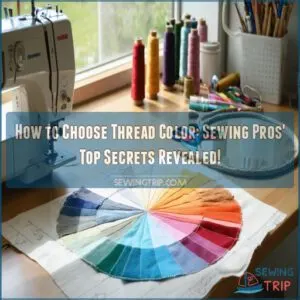
Start by holding your thread against the fabric in natural light—your secret weapon for true color detection.
For invisible seams, go a shade darker than your fabric; it’s like a chameleon trick that blends seamlessly.
Want to make a statement?
Contrast boldly with complementary colors that pop.
Pro tip: always test on fabric scraps first—no one wants a sewing surprise!
Whether you’re working with delicate silk or sturdy denim, matching thread means the difference between a homemade look and a professional finish.
Ready to elevate your sewing game?
Table Of Contents
Key Takeaways
- Choose your thread color by holding it against the fabric in natural light to ensure true color matching and achieve a seamless, professional finish.
- Match your thread to the fabric’s dominant color or go a shade darker for invisible seams, or use a contrasting color to create a bold, intentional design statement.
- Consider the thread’s weight and material based on your fabric type, ensuring durability and compatibility with your sewing machine for the best topstitching results.
- Always test your thread color and tension on fabric scraps first, as this simple step can prevent unexpected surprises and help you achieve a polished, professional-looking project.
Choosing Thread Color
Choosing the right thread color can make or break your sewing project, transforming a good design into a professional-looking masterpiece.
When you select the perfect thread shade, you’ll create seamless, polished results that’ll have everyone wondering how you achieved such a flawless finish.
Matching Thread to Fabric
Matching thread to fabric is like finding the perfect dance partner – it’s all about harmony.
When selecting thread color, aim for a shade that blends seamlessly with your fabric’s dominant color.
Pro tip: go slightly darker for invisible seams.
Hold your thread against the fabric in natural light to nail that perfect thread color selection.
Considering Fabric Patterns
When working with printed fabrics, your thread color is your secret weapon.
Think of it like a chameleon – you’ll want to blend seamlessly with the dominant hues.
For complex prints, pick a thread that matches the background or main color.
Get strategic: pull your thread across the fabric and see how it disappears into the pattern, ensuring invisible, professional-looking seams.
To achieve superior results, understanding thread color choices is essential for selecting the perfect thread that complements your fabric.
Thread Color Basics
After exploring fabric patterns, let’s nail down thread color basics like a pro.
Color Theory isn’t rocket science—it’s about making smart choices that elevate your project.
Here’s what you’ll want to remember about thread shades:
- Natural light reveals true colors
- Darker threads hide better
- Background tones matter most
- Consistent color wins every time
Your thread color can make or break the final look, so choose wisely and sew with confidence.
Thread Types and Materials
You’ll find thread types as diverse as your fabric collection, with each material bringing its own superpower to your sewing project.
Whether you’re working with polyester’s versatility, cotton’s classic charm, or nylon’s tough-as-nails strength, choosing the right thread can make or break your final creation.
Polyester Thread Uses
After nailing your fabric color game, polyester thread emerges as a sewing superhero.
Its versatility shines through different projects, offering superior durability and color fastness.
Top stitching tips reveal polyester’s strength across various fabrics, adapting seamlessly to sewing machines.
Whether you’re working on lightweight or heavy materials, this thread type delivers consistent performance that’ll make your projects pop.
For ideal results, understanding polyester thread properties is essential to choose the right thread for your sewing projects.
Cotton Polyester Blends
Someone might wonder why cotton-polyester blend threads are a game-changer for sewists seeking versatile performance.
These dynamic threads offer unique advantages that elevate your sewing projects:
- Soft feel with exceptional strength
- Balanced wash performance
- Reduced shrinkage compared to pure cotton
- Excellent compatibility with various fabric textures
Cotton’s natural comfort meets polyester’s durability, creating a thread that handles everything from delicate quilts to robust denim with professional finesse.
Nylon Bonded Threads
After exploring cotton-polyester blends, let’s gear up for nylon bonded threads – your secret weapon for heavy-duty sewing.
These threads pack a punch with incredible durability, preventing fabric fraying like a champ.
Perfect for topstitching challenging materials, nylon threads resist wear and tear, giving your projects superhero-level strength.
Pro tip: always test thread resilience before committing to your masterpiece.
Thread Fiber Content
Picking the right thread fiber is like choosing your sewing superhero.
Cotton reigns supreme for natural fabrics, offering breathability and softness.
Polyester brings versatility to the table, while nylon tackles heavy-duty projects with grit.
Silk steps up for delicate textiles.
Thread fiber content isn’t just about strength—it’s about matching your project’s unique personality and performance needs.
Understanding cotton thread properties can help sewers make informed decisions about their projects, considering the natural fabrics they work with.
Selecting Topstitch Thread
For topstitching, you’ll want to select a thread that both complements your fabric and accentuates your project’s professional finish.
Your thread choice can influence the visual appeal, so take a moment to evaluate color, weight, and material before you start stitching.
Thread Weight and Fabric
After exploring polyester and cotton threads, you’ll want to match your thread weight precisely to your fabric type.
Thicker fabrics cry out for sturdier threads, while delicate materials beg for finer strands.
Your sewing machine’s tension and the fabric’s stretch will guide your thread durability choice.
Understanding the importance of thread selection basics is essential for achieving professional-looking results.
Pro tip: Always test on a scrap before committing to your main project.
Thread Size and Color
After mastering thread weight, you’ll want to zero in on thread size and color that makes your project pop.
Your thread color palette is your secret weapon for seamless stitching.
Consider these top thread color options:
- Match dominant fabric color
- Pull thread across material
- Test in natural light
- Check thread thickness
- Evaluate yarn thickness
Choosing the right top stitch thread is essential for a professional finish.
Nail your topstitching thread picks with confidence and style.
Thread Color Matching Techniques
When choosing thread color for your sewing project, you’ll want to match your thread to the fabric’s dominant color for a seamless, professional look.
By understanding a few simple techniques, you’ll be able to select the perfect thread that blends beautifully or creates a striking contrast with your chosen material.
Dominant Color Selection
After nailing topstitching techniques, let’s unravel the art of dominant color selection in thread matching.
Understanding which color takes center stage can make or break your sewing project.
Here’s a quick guide to identifying your fabric’s true color champion:
| Color Characteristic | Left Hand Test | Visual Placement |
|---|---|---|
| Dominant Strands | Held left | Pushed forward |
| Color Position | Left side | Foreground |
| Placement Rule | Left hand hold | Front of fabric |
| Color Hierarchy | Stands out | Most visible |
Color harmony starts with knowing which thread hue truly leads the pack.
Contrasting Thread Colors
Break the monotony with contrasting thread colors to transform your sewing project from bland to brilliant!
Thread color selection can create stunning visual impact when done right.
Consider these topstitching color tips:
- Choose a thread shade that dramatically differs from your fabric’s base color
- Highlight architectural seams with bold, unexpected thread choices
- Use color contrast to draw attention to intricate design details
- Experiment with complementary color wheel opposites for maximum stitch definition
The key to a successful project is selecting the right thread color to create a stunning visual impact.
Matching Thread to Fabric Weight
Want to ace your thread game?
After playing with contrasting colors, it’s time to match thread weight to fabric density.
Lightweight fabrics cry out for fine threads, while heavy materials demand sturdy companions.
Your sewing machine’s thread tension can make or break the project, so test different thread weights on fabric scraps to guarantee durability and a professional finish.
Thread Size Charts
After matching thread weights to fabric thickness, thread size charts become your secret weapon.
These handy guides decode the mystery of sewing machine compatibility, helping you select the perfect top stitch thread.
Whether you’re eyeing thread color selection or exploring fabric density, a good thread chart is like having a pro sewist whispering insider tips right in your ear, and it’s all about finding the right balance to make your sewing project stand out with the perfect thread size charts.
Topstitching Thread Considerations
When you’re ready to take your sewing projects from basic to brilliant, mastering topstitching thread considerations is your secret weapon.
You’ll want to pay close attention to thread tension, bobbin selection, and brand quality to guarantee your stitches appear professional and stay put.
Tension Settings
After nailing color matching, you’ll want to crack the code of thread tension.
Your sewing machine’s hidden superpower lies in precise Sewing Machine Calibration.
- Test stitch samples on scrap fabric
- Adjust Needle Tension incrementally
- Watch for balanced stitch formation
- Listen to your machine’s subtle feedback
Thread Tension Control isn’t rocket science – it’s about feeling the fabric’s resistance and finding that sweet spot where stitches look flawless on both sides, which is the key to thread tension.
Bobbin Thread Selection
After fine-tuning your thread tension, select your bobbins thread wisely.
Regular all-purpose thread works best, keeping your sewing machine happy.
Thinner bobbin threads typically create smoother stitches.
Pro tip: Match bobbin thread color carefully—it’s trickier than you might think.
Experiment with different thread tensions to achieve those picture-perfect seams that’ll make your project shine.
Thread Brand Quality
After wrestling with bobbin thread woes, you’ll want to zero in on thread brand quality.
Top manufacturers like Gutermann and Superior Threads offer reliability that can make or break your project.
Check manufacturer ratings, compare fiber strength, and don’t skimp on quality.
Your topstitching thread should be a dependable partner, turning potential sewing struggles into smooth, professional-looking results.
Understanding the types of thread is essential for achieving the best possible outcome in your sewing projects.
Finalizing Thread Color Choice
You’ve spent hours selecting the perfect fabric and thread, so don’t let your hard work unravel with a hasty color choice.
Trust your eye, test your options in natural light, and remember that the right thread color can make or break your sewing project’s professional finish.
Considering Visual Appeal
After mastering thread tension, it’s time to elevate your project’s style game.
Visual appeal isn’t just about color matching—it’s about creating Color Harmony that makes your stitches sing.
Whether you’re aiming for Texture Contrast or subtle Design Elements, your thread color selection can transform a good project into a showstopper that catches every eye.
To achieve this, understanding thread color choices is vital for making informed decisions about the aesthetic of your sewing projects, which involves considering thread color choices to make your project stand out.
Ensuring Seam Durability
The key to seam durability lies in strategic thread selection that matches your fabric’s unique characteristics.
Test thread strength by pulling it against different fabric weights, ensuring your top stitch thread can handle the project’s demands.
Durability testing prevents frustrating thread breaks and maintains seam quality, giving your creation the resilience it deserves.
Maintaining Consistent Thread Color
When your seams demand visual perfection, maintaining thread color consistency becomes your secret weapon.
Color harmony isn’t just about matching—it’s about creating a seamless narrative across your entire project.
Your thread tells a story, and interrupting that story mid-project can scream "amateur hour."
- Store threads away from direct sunlight to prevent fading
- Purchase threads from the same dye lot
- Check thread color under natural light before stitching
- Keep a consistent brand for uniform color shades
Frequently Asked Questions (FAQs)
What thread is best for topstitching?
Choose polyester or cotton-covered polyester thread for topstitching.
It’s strong, versatile, and works well on denim, leather, and outdoor gear.
Pick a thread that matches your fabric’s weight and project requirements.
How do you pick the color of thread?
Want your topstitching to pop or blend?
Hold thread against fabric in natural light, matching its dominant color.
For a professional finish, opt for a thread slightly darker than your material’s background.
How would you choose the appropriate color of the thread?
When picking thread for topstitching, match it to your fabric’s dominant color or create a bold contrast. Test different shades in natural light, ensuring your stitches look crisp and intentional.
Does it matter what color thread you use?
Picture a thread screaming "look at me!" or whispering like a secret – the color absolutely matters.
Your topstitching thread can either pop dramatically or blend seamlessly, transforming your project’s entire visual appeal.
How do I choose topstitching thread for embellishments?
For embellishments, grab a thread that either matches your fabric’s dominant color or creates a bold contrast.
Test different shades on a scrap piece to nail the perfect visual impact that’ll make your project pop.
Can metallic threads work for topstitching projects?
Metallic threads can add sparkle to topstitching, but they’re tricky.
You’ll need a special needle, reduced tension, and patience.
Test on scrap fabric first to avoid frustration and guarantee smooth, eye-catching stitches.
What thread works best for vintage repairs?
For vintage repairs, choose cotton thread matching the fabric’s era.
Opt for fine, high-quality threads in neutral tones that won’t weaken delicate materials.
Test thread strength and color on inconspicuous areas before stitching.
How do I blend decorative topstitching seamlessly?
Ever wondered how to make your topstitching look like a pro did it?
Choose a thread color slightly darker than your fabric, test on a scrap first, and adjust your machine’s tension for that seamless, polished finish.
Are specialty threads worth the extra cost?
Specialty threads can elevate your project, but they’re not always necessary.
Weigh the cost against your sewing goals.
High-quality threads improve durability and appearance, so splurge when it truly matters for professional-looking results.
Conclusion
Picture Sarah, a beginner seamstress who transformed her grandmother’s vintage dress by perfectly matching thread color.
Mastering how to choose thread color for top stitching isn’t just about matching—it’s about creating professional-looking garments.
You’ll discover that the right thread can elevate your sewing from amateur to expert, and trust your eye is crucial in this process.
Test on scraps, and remember: thread color is your secret weapon for stunning, polished projects that showcase your craftsmanship.
- https://www.thesprucecrafts.com/choose-sewing-thread-color-type-and-fibers-2978366
- https://www.tracecreekquilting.com/whatshappening/picking-thread-color
- https://auribuzz.com/2016/05/10/thread-matters-choosing-the-right-color/
- https://www.blog.wawak.com/amp/choosing-a-top-stitch-thread
- https://www.stringandstory.com/blog/choosing-a-thread-color-for-quilting

